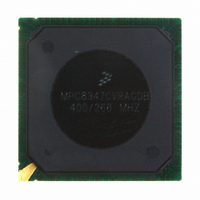MPC8347CVRAGDB Freescale Semiconductor, MPC8347CVRAGDB Datasheet - Page 86

MPC8347CVRAGDB
Manufacturer Part Number
MPC8347CVRAGDB
Description
IC MPU POWERQUICC II 620-PBGA
Manufacturer
Freescale Semiconductor
Series
PowerQUICC II PROr
Specifications of MPC8347CVRAGDB
Processor Type
MPC83xx PowerQUICC II Pro 32-Bit
Speed
400MHz
Voltage
1.2V
Mounting Type
Surface Mount
Package / Case
620-PBGA
Core Size
32 Bit
Program Memory Size
64KB
Cpu Speed
400MHz
Embedded Interface Type
I2C, SPI, USB, UART
Digital Ic Case Style
BGA
No. Of Pins
672
Rohs Compliant
Yes
Lead Free Status / RoHS Status
Lead free / RoHS Compliant
Features
-
Available stocks
Company
Part Number
Manufacturer
Quantity
Price
Company:
Part Number:
MPC8347CVRAGDB
Manufacturer:
FREESCA
Quantity:
13
Company:
Part Number:
MPC8347CVRAGDB
Manufacturer:
Freescale Semiconductor
Quantity:
10 000
Thermal
20.2.3
To determine the junction temperature of the device in the application after prototypes are available, use
the thermal characterization parameter (
temperature at the top center of the package case using the following equation:
where:
The thermal characterization parameter is measured per the JESD51-2 specification using a 40 gauge type
T thermocouple epoxied to the top center of the package case. The thermocouple should be positioned so
that the thermocouple junction rests on the package. A small amount of epoxy is placed over the
thermocouple junction and over about 1 mm of wire extending from the junction. The thermocouple wire
is placed flat against the package case to avoid measurement errors caused by cooling effects of the
thermocouple wire.
20.2.4
Some application environments require a heat sink to provide the necessary thermal management of the
device. When a heat sink is used, the thermal resistance is expressed as the sum of a junction-to-case
thermal resistance and a case-to-ambient thermal resistance:
where:
R
change the case-to-ambient thermal resistance, R
sink, the air flow around the device, the interface material, the mounting arrangement on printed-circuit
board, or change the thermal dissipation on the printed-circuit board surrounding the device.
The thermal performance of devices with heat sinks has been simulated with a few commercially available
heat sinks. The heat sink choice is determined by the application environment (temperature, air flow,
adjacent component power dissipation) and the physical space available. Because there is not a standard
application environment, a standard heat sink is not required.
86
θ
JC
is device-related and cannot be influenced by the user. The user controls the thermal environment to
T
T
Ψ
P
R
R
R
J
T
D
θ
θ
θ
JT
JA
JC
CA
= junction temperature (°C)
= thermocouple temperature on top of package (°C)
= power dissipation in the package (W)
MPC8347EA PowerQUICC II Pro Integrated Host Processor Hardware Specifications, Rev. 11
Experimental Determination of Junction Temperature
Heat Sinks and Junction-to-Case Thermal Resistance
= junction-to-ambient thermal resistance (°C/W)
= junction-to-ambient thermal resistance (°C/W)
= junction-to-case thermal resistance (°C/W)
= case-to-ambient thermal resistance (°C/W)
T
R
J
θ
JA
= T
= R
T
+ (
θ
JC
Ψ
+ R
JT
× P
Ψ
θ
CA
JT
D
) to determine the junction temperature and a measure of the
)
θ
CA
. For instance, the user can change the size of the heat
Freescale Semiconductor











